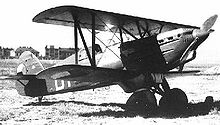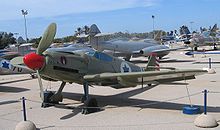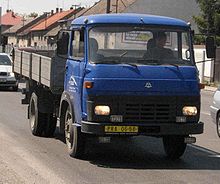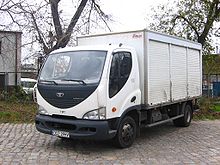Avia Picture

|
|

|
Avia
Avia is a Czech aircraft and automotive company notable for producing biplane fighter aircraft, especially the B-534, and trucks.
History
The company was founded by Miroslav Hajn and Pavel Bene in 1919 and became part of Å koda in 1928. During the 1930s the factory became the biggest aircraft producer in Czechoslovakia and moved to LetÅany. During World War II Avia produced aircraft for the German Luftwaffe. After the war the company was nationalized and became involved in the automotive industry. It manufactured aircraft up to 1963, then continued to make aircraft engines (producing only propellers from 1988) and targeted truck production. The company was split in 1992 into propeller and truck sections, both using the Avia brand.
Aircraft

Picture - Avia B-534
Before the war the company produced civilian and military aircraft, including the Avia BH-21, Avia B-534 and Avia B-71 (Soviet licensed Tupolev SB).
Avia had started building Messerschmitt Me 109G soon after WWII as the Avia S-99, but soon ran out of the 109's Daimler-Benz DB 605 engine.
Also during the war the Germans set up a number of assembly plants in Czechoslovakia for production of the Messerschmitt Me 262, designated the Avia S-92. After the war the manufacturing infrastructure remained intact, so production could start up again for the new owners.
The first S-92 was assembled at LetÅany Research Institute in 1945 with the airframes coming from Avia and the engines from the repair works in Maleice (the Junkers Jumo 004, now called the M-04). The S-92's first flight was on 27 September 1946, with Avia's chief pilot Antonin Kraus in control. That same year on December 10 the CS-92 took to the air for the first time.
Delivery of the first S-92 to the Czechoslovak Air Force was on 6 February 1948. Twelve were made in all, nine S-92 and three CS-92, equipping the 5th Fighter Flight, until they were grounded for use as instructional airframes in 1951.

Picture - Avia S-199
By the time Yugoslavia showed interest in buying the S-92, Avia was looking at closing down the production line to make way for newer up-to-date aircraft, and when Avia were given a license to make the Mikoyan-Gurevich MiG 15 Fagot (they were already making the Yakovlev Yak 23 Flora, as the S-101) the S-92 production lines were dismantled.
An Avia S-92 (A-1a) and Avia CS-92 (B-1a) can be seen at the Vojenské Muzeum, Kbely AB.
The Avia S-199 was a fighter aircraft built in Czechoslovakia after World War II using parts and plans left over from Luftwaffe aircraft production that had taken place in the country during the war. While a problematic aircraft, unpopular with its pilots, it achieved fame as the first fighter obtained by the Israeli Air Force for use during the War of Independence. Czechoslovak pilots nicknamed it Mezek ("Mule"), whilst in Israel it was known as the Messer ("knife"; it is a common mistake that it was nicknamed Sakeen; the official name was even different - Python).
The S-199 continued to use the Me 109G airframe, but with none of the original engines available, the engine (Junkers Jumo 211) and propeller from the Heinkel He 111 bomber were used instead. The result of this compromise was an aircraft with poor handling qualities. The substitute engine lacked the responsiveness of the Daimler-Benz unit, was heavier, and the torque created by the massive paddle-bladed propeller made control difficult. This latter flaw, combined with the 109's narrow-track undercarriage also made landings and take-offs more hazardous. A final hidden danger lay in the synchronization gear which did not seem to work properly, leading a few Israeli aircraft to shoot off their own propellers.
Later produced Avia B-33 (licensed Ilyushin Il-10) or Avia 14 (licensed Ilyushin Il-14), that airliner version (able to carry 42 passengers) became the largest aircraft ever produced in Czechoslovakia.
List of aircraft
Avia BH-1 (1920) Single-piston-engine monoplane two-seat touring aircraft. One built
Avia BH-2 (1921) Single-piston-engine monoplane one-seat touring aircraft. One built
Avia BH-3 (1921) Fighter aircraft development of BH-2
Avia BH-4 (1922) Development of BH-3 with larger engine. ne built
Avia BH-5 (1923) Single-piston-engine monoplane two-seat touring aircraft. One built
Avia BH-6 (1923) Single-piston-engine one-seat biplane fighter aircraft. One built
Avia BH-7 (1923) Single-piston-engine one-seat parasol-wing fighter/racer aircraft. Two built
Avia BH-8 (1923) Development of BH-6. One built
Avia BH-9 (1923) Development of BH-5
Avia BH-10 (1924) Development of BH-9. One-seat sport aircraft
Avia BH-11 (1923) Development of BH-9. Two-seat sport aircraft
Avia BH-12 (1924) Development of BH-9 with foldable wings
Avia BH-16 (1924) Very light single-piston-engine one-seat monoplane touring aircraft
Avia BH-17 (1924) Single-piston-engine one-seat biplane fighter aircraft
Avia BH-19 (1924) Development of BH-3. Two built
Avia BH-20 (1924) Single-piston-engine two-seat biplane training aircraft
Avia BH-21 (1925) Single-piston-engine one-seat biplane fighter/racing aircraft
Avia BH-22 (1924) Single-piston-engine rwo-seat trainer aircraft. Developed from BH-21
Avia BH-23 (1926) Night-fighter development of BH-21 and BH-22. Two built
Avia BH-25 (1926) Single-piston-engine seven-seat biplane transport aircraft
Avia BH-26 (1927) Single-piston-engine two-seat biplane reconnaissance aircraft
Avia BH-27 (late 1920s) Single-piston-engine four-seat high-wing monoplane transport aircraft. Not built
Avia BH-28 (1927) Single-piston-engine two-seat biplane reconnaissance aircraft. One built
Avia BH-29 (1927) Single-piston-engine two-seat biplane trainer aircraft
Avia BH-33 (1927) Single-piston-engine one-seat fighter aircraft. Development of BH-21 with larger engine
Avia BH-39 (1929) Czech bomber adaptation of Fokker F.IX, three-piston-engine high-wing monoplane
Avia B-34 (1932) Single-piston-engine one-seat biplane fighter
Avia B-534 (1933) Single-piston-engine one-seat biplane fighter
Avia B-122 (1934) Single-piston-engine one-seat biplane aerobatic aircraft
Avia B-71 (1934) Czech version of Russian Tupolev SB two-piston-engine monoplane bomber
Avia B-35 (1938) Single-piston-engine monoplane fighter
Avia B-135 (1938) Production version of B-35 with metal wing
Avia B-158 (1938) Twin-engined medium bomber, prototype only
Avia S-92 (1944) Czech production version of German Me 262, two-jet-engine one- or two-seat fighter aircraft
Avia S-99 (1945) Czech postwar production of German Bf-109G single-piston-engine fighter aircraft
Avia B-33 (1944) Czech production version of Russian Ilyushin Il-10, single-piston-engine two-seat low-wing ground-attack aircraft
Avia S-199 (1947) Development of S-99 using different engine and propeller
Avia 14 (1950) Czech version of Russian Ilyushin Il-14, two-piston-engine airliner
Private Automobiles
In 1956, Avia made prototypes of a small automobile. It had a single centrally-placed front seat and steering column, two rear seats, a sliding cabin for access, and a rear-mounted 2-cylinder 350cc Jawa motorcycle engine. The layout was shared with the Moravan car, which was built at Otrokovice.
Trucks

Picture - Saviem based Avia truck
Soon after the War, the manufacture of fuel injection pumps, jets and roller bearings for freight vehicle transport was implemented in AVIA. The factory also provided repair of trucks. In frame of the Czechoslovak industry post-war reorganization it was subsequently decided that AVIA would be fully transformed into the manufacture of new trucks. As early as 1946 a prototype of the Å koda R-706 vehicle was developed, and the first vehicle and bus series was manufactured in 1947. These products were successfully exported to many countries
First of all, the enterprise concentrated on assembling T-805 vehicles. In 1961, it switched to the manufacture of Praga V3S/ S5T, the medium duty truck. The legendary three-tone off-road V3S was maintained in AVIA's manufacturing program until 1988. The vehicle was manufactured not only as a platform car but with different types of bodies as well. It fully utilised its construction designed for extraordinarily heavy use in the army, on site, in forest as well as in any other operation demanding a high performance under the heaviest conditions. The modifications of the Praga S5T model also included a semitrailer truck, S5T-TN model with a â trambusâ cabin. In 1963, manufacture of chassis units for the OT 64 (SKOT) armoured carrier was launched. Praga and Tatra enterprises, but also some Polish manufacturers participated on the manufacture.
In 1965, structural changes of demand concerning a small tonnage lorry appeared both in national and international market. At the AVIA enterprise, they were considering two ways ahead, i.e. own development and/or use of a suitable licence strategy. As a conclusion, the French Renault-Saviem manufacturerâs offer for two types of trucks was accepted. In the autumn of 1968, the first products started to leave the assembly line. The larger vehicle was named Renault-Saviem SG 4 Super Galion (later AVIA A30), and the smaller was named SG 2 Super Goelette (later AVIA A15). The new manufacture as well as its scope required new buildings as well as modernization of existing enterpriseâs premises. New big buildings containing advanced equipment were constructed and thus AVIA was included among the largest Czechoslovak car manufacturers. The yearly production reached 17,000 vehicles. During the years, the manufacture of the AVIA vehicles was continuously modernized. The volume of the Diesel engine increased from original 3.32 up to 3.61, and practically all vehicle units were adapted. In 1983, the AVIA A31 developed from the AVIA A30 model, while the AVIA A15 (later A20) furgon was transferred to the AVIA A 21 model. From 1974 to 1978, modernization of A20, 30, and 40 models was prepared, bringing small wheels, redesigned axles, new dashboard, enhanced cab interior, etc.

Picture - Daewoo Avia D90
In 1986, the AVIA National Concern comprising also affiliates in Brno, IvanÄice and Žilina was incorporated in a so-called âIndustry Economical Unitâ together with Praga, BSS, Metaz and Kutnx¡ Hora enterprises. As per 1st July 1988, a new state enterprise, AVIA Concern, comprising Avia, Praga, BSS, and DaÄické strojxrny concern enterprises was established in accordance with the State Enterprise Act. AVIA LetÅany as the parent factory manufactured engines and cabs and assembled all of the chassis. A part of the chassis was fitted with a platform-type superstructure and also vehicles with a furgon-type body were manufactured here. The Brno, IvanÄice and Žilina factories purpose superstructures were assembled on the chassis. The Kutnx¡ Hora factory manufactured all types of axles for AVIA vehicles. The key assortment of Praga Concern Enterprise included truck and bus gear units and a number of other parts for the automotive field. The DaÄické strojxrny Concern Enterprise produced parts for our car manufacturers. The body assortment was still growing: box bodies, isothermic box bodies, bodies including a cooling unit, assembly platforms, container bodies, dumpers, towing trucks, and other different bodies were manufactured. The AVIA chassis also served as a base for the small buses manufactured in Bulgaria, Yugoslavia and Hungary.
In 1989, the concern split in single businesses. In the same year, AVIA LetÅany launched assembly of A21 FC furgons by use of pressed parts. In 1993, manufacture of AVIA vehicles equipped with turbo engines designated as A21T and A31T was launched. At the same time, the engine power of these vehicles was increased up to 65 kW, which met the EURO I Standard. Subsequently, an engine with the power increased up to 76 kW (or 85 kW) and intercooler meeting the EURO II Standard was developed. The enhancements also included a modified chassis, strengthened drive unit, power steering system, modified braking system, improved cab interior and enhanced technical parameters of the vehicle.
In 1992, AVIA was transformed into a stock company, and also Avia - Hamilton Standard, a new company with AVIA's equity share manufacturing aircraft propeller was established. One year later, the propeller manufacture was moved from the LetÅany factory to the new premises near Starx¡ Boleslav. This definitively terminated the aircraft production in LetÅany.
66% of the AVIA Company was privatized by Czech entities in two waves. To ensure the further development of the Company, the Government began to seek for a foreign investor. The relevant discussions were led with several parties concerned. In the first line, it was RENAULT, the French car manufacturing company, with which AVIA already had good long-term experience; followed by the German MERCEDES-BENZ company. However, the 1995 public tender was won by a consortium formed by the South Korean DAEWOO company and Austrian STEYR company. The consortium bought 50.2% of AVIA's shares, thus becoming the majority owner of the Company. The year after, the trade name of the Company was changed to DAEWOO AVIA, a.s. In the same year, the Company became the exclusive importer and distributor of DAEWOO vehicles for the Czech Republic.
In 1997, the AVIA A Series was modernized for the last time. AVIA A 60/ 65/ 75/ 80 models entered the market. The vehicles had a completely new chassis fitted with a riveted frame, fixed front axle, front disk brakes, lesser wheels 205/75 - 17,50" and EURO II engines with the power of 76 kW and/or 85 kW. The vehicles were fitted with a five-speed/six-speed gear-box. The cabs had a new interior, advanced design and they were tilt cabs in the first line. Generally, 250,000 AVIA A Series vehicles, which can be seen in high numbers on our roads even today, left the assembly line of the LetÅany car factory in the period between launching the production in 1968 up to its termination, which took place on 13th November 2000. From 1997 to 1999, the LetÅany car factory was also assembling LUBLIN and LUBLIN II, the light commercial vehicles imported disassembled from the DAEWOO MOTOR POLAND company.
Simultaneously, preparation work on a completely new product continued. The DAEWOO AVIA´s new management team staked a demanding goal comprising of development and implementation of a completely new medium duty truck, which would cover the 6 to 9 tonnes weight class and would be fully competitive in the western markets in terms of design. The vehicle cab, which got a completely new design and provided a maximum comfort both to driver and crew, was the most significant component of the vehicle. The English DAEWOO designers took a part in the development of the new cab and its interior, while DAEWOO AVIA specialist designers were responsible for the project co-ordination, and engine/chassis development. The new vehicle known as AVIA D Series had its debut in the Czech market in the end of 2000. The major change that came along with the AVIA D 60/90 Series vehicles was mounting of new driving units meeting the legal requirements of EEC R49-03 without a need to re-circulate the exhaust gases. The units included a self-constructed and self-produced engine titled as AVIA D432.100, and CUMMINS ISBe 150 30 engine (England). The CUMMINS engine, with its more even speed-torque characteristic, has applied its advantage namely in more distant transports. Since 2002, the manufacturer has been offering two German ZF companyâs gear-box types with the vehicles. Specifically, it comprises the ZF S5-42 five-speed gear-box or ZF S6-850 six-speed gear-box.
However, by the middle of this decade, the operations shrank and volumes dwindled, to reach 650 in 2006, though sales demand remained strong in the home market and in the UK, Spain, Hungary and Ireland - in the latter, Avia had a 16% market share of its segment in 2006. In 2007, a leading commercial vehicle manufacturer from India, Ashok Leyland, took over AVIA. The company has since been renamed Avia Ashok Leyland Motors (AALM).
Soon thereafter, Euro 4-compliant models were introduced in the market. And the strengthening of the marketing infrastructure is on, to support the ramp up of volumes at AALM.
AALMâs range today spans the gross vehicle weight range from 6 tones to 12 tones. Dependent upon model the gross combination weight with a drawbar trailer can be as high as 22 tones, providing for highly economical operation.
As a truck maker, Czech Avia should not be confused with the Spanish Avia.
Avia Pictures and Avia for Sale.
Living Warbirds: The best warbirds DVD series.
Source: WikiPedia